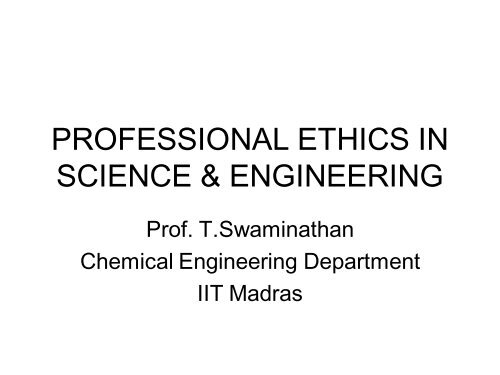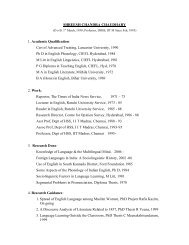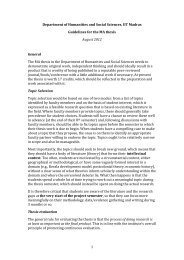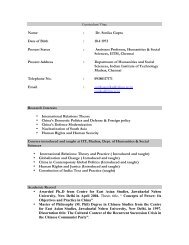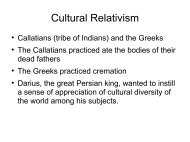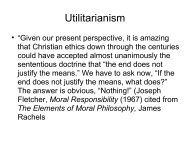professional ethics in science & engineering - Department of ...
professional ethics in science & engineering - Department of ...
professional ethics in science & engineering - Department of ...
Create successful ePaper yourself
Turn your PDF publications into a flip-book with our unique Google optimized e-Paper software.
PROFESSIONAL ETHICS IN<br />
SCIENCE & ENGINEERING<br />
Pr<strong>of</strong>. T.Swam<strong>in</strong>athan<br />
Chemical Eng<strong>in</strong>eer<strong>in</strong>g <strong>Department</strong><br />
IIT Madras
TYPES OF EMPLOYMENT<br />
JOB – low-skill level required<br />
TRADE – manual skills, apprenticeships,<br />
<strong>of</strong>ten unionized<br />
KNOWLEDGE WORKER – specifically<br />
educated or tra<strong>in</strong>ed<br />
PROFESSIONAL – regulated knowledge<br />
worker<br />
SELF-EMPLOYED – non-<strong>pr<strong>of</strong>essional</strong> or<br />
<strong>pr<strong>of</strong>essional</strong>
PROFESSIONALS<br />
Doctors<br />
Dentists<br />
Veter<strong>in</strong>arians Pharmacists<br />
Lawyers<br />
Accountants<br />
Architects Teachers<br />
Eng<strong>in</strong>eers Journalists<br />
Stock Brokers Athletes (?)
WHO IS A PROFESSIONAL?<br />
Orig<strong>in</strong>ally, one who pr<strong>of</strong>essed adherence to<br />
monastic vows <strong>of</strong> a religious order.<br />
* a free act <strong>of</strong> commitment to a specific<br />
way <strong>of</strong> life<br />
* allegiance to high moral standards<br />
* skill, knowledge, practice <strong>of</strong> an art
WHO IS A PROFESSIONAL?<br />
Today, it is one who is “duly qualified” <strong>in</strong> a<br />
specific field<br />
* special knowledge or education<br />
* appropriate experience<br />
* knowledge and skills vital to the wellbe<strong>in</strong>g<br />
<strong>of</strong> a large potion <strong>of</strong> society<br />
* special sanction
PROFESSIONAL TRAITS<br />
Extensive <strong>in</strong>tellectual tra<strong>in</strong><strong>in</strong>g (education)<br />
Specialized knowledge<br />
Skills vital to society<br />
Monopoly on service provided<br />
Autonomy, self-regulated<br />
Privilege/prestige<br />
Governed by a code <strong>of</strong> <strong>ethics</strong>
IS ENGINEERING A PROFESSION?<br />
Eng<strong>in</strong>eer<strong>in</strong>g meets all the def<strong>in</strong>itions <strong>of</strong> a<br />
pr<strong>of</strong>ession.<br />
Eng<strong>in</strong>eers do not always hold the same<br />
status <strong>in</strong> society as that <strong>of</strong> lawyers or<br />
doctors.
MODELS OF PROFESSIONALISM<br />
Social Contract Model<br />
* <strong>pr<strong>of</strong>essional</strong> are guardians <strong>of</strong> public<br />
trust<br />
* an implicit, unstated agreement<br />
exists between <strong>pr<strong>of</strong>essional</strong> and<br />
society<br />
* society may subsidize tra<strong>in</strong><strong>in</strong>g <strong>of</strong><br />
<strong>pr<strong>of</strong>essional</strong>s
THE IMPLICIT AGGREEMENT<br />
Pr<strong>of</strong>essionals agree to:<br />
* provide a service<br />
- for the public well-be<strong>in</strong>g<br />
- promote public welfare, even at<br />
own expense<br />
* self-regulation<br />
- enforce competence<br />
- enforce ethical standards
THE IMPLICIT AGGREEMENT<br />
Society agrees to:<br />
* allow a certa<strong>in</strong> autonomy<br />
- freedom <strong>of</strong> self-regulation<br />
- freedom to choose clients<br />
* social status<br />
- respect from society, titles<br />
* high remuneration<br />
- reward for services<br />
- attract competent <strong>in</strong>dividuals
ENGINEERING - HISTORICAL<br />
PERSPECTIVE<br />
A pr<strong>of</strong>ession that put power and materials to<br />
work for the benefit <strong>of</strong> mank<strong>in</strong>d.<br />
In ancient times, there was no formal<br />
eng<strong>in</strong>eer<strong>in</strong>g education.<br />
Eng<strong>in</strong>eers built structures by trial and error.<br />
Eng<strong>in</strong>eer<strong>in</strong>g advances were made by<br />
learn<strong>in</strong>g from mistakes
ANCIENT CONSTRUCTION<br />
Examples:<br />
* Great wall <strong>of</strong> Ch<strong>in</strong>a<br />
* The pyramids <strong>in</strong> Egypt<br />
* The coliseum <strong>in</strong> Rome<br />
* Hadrian’s wall <strong>in</strong> the U.K.<br />
* The Pont du Gard <strong>in</strong> France<br />
* The dikes <strong>in</strong> the Netherlands
“MACHINES” OF WAR<br />
Examples:<br />
* bows and cross-bows<br />
* catapults<br />
* assault towers & batter<strong>in</strong>g rams<br />
* ships <strong>of</strong> war<br />
* rockets<br />
* Greek fire
SCIENCE AND ENGINEERING<br />
It is a undeniable pr<strong>in</strong>ciple that the entire<br />
practice <strong>of</strong> <strong>science</strong> and eng<strong>in</strong>eer<strong>in</strong>g is<br />
based on a set <strong>of</strong> expected ethical<br />
behaviors for all <strong>in</strong>volved. This <strong>in</strong>cludes<br />
the expectation <strong>of</strong> honesty and<br />
truthfulness <strong>in</strong> all <strong>in</strong>dividual activities,<br />
contacts, and <strong>in</strong>teractions with<strong>in</strong> the<br />
pr<strong>of</strong>ession.
HONESTY<br />
“If we consider the eng<strong>in</strong>eer<strong>in</strong>g<br />
pr<strong>of</strong>ession to be like a build<strong>in</strong>g,<br />
honesty is its foundation.<br />
Without honesty, the value <strong>of</strong><br />
eng<strong>in</strong>eer<strong>in</strong>g services is<br />
underm<strong>in</strong>ed.”<br />
Harris, Pritchard and Rab<strong>in</strong>s<br />
Second Edition
MISUSING THE TRUTH<br />
Eng<strong>in</strong>eers can misuse the truth by:<br />
* fail<strong>in</strong>g to communicate the truth<br />
* communicat<strong>in</strong>g the truth when they<br />
should not<br />
* allow<strong>in</strong>g their judgment regard<strong>in</strong>g the<br />
truth to be corrupted
COMMUNICATING THE TRUTH<br />
• Ly<strong>in</strong>g<br />
• Deliberate deception<br />
• Withhold<strong>in</strong>g <strong>in</strong>formation<br />
• Fail<strong>in</strong>g to adequately promote<br />
the dissem<strong>in</strong>ation <strong>of</strong> <strong>in</strong>formation<br />
• Failure to seek out the truth
FAILURE TO PROMOTE DISSEMINATION<br />
OF INFORMATION<br />
Our ethical obligation to promote the health<br />
and safety <strong>of</strong> the public:<br />
* may require the eng<strong>in</strong>eer to disclose<br />
<strong>in</strong>formation<br />
* requires that the eng<strong>in</strong>eer ensure that<br />
the <strong>in</strong>formation is dissem<strong>in</strong>ated<br />
appropriately
FAILURE TO SEEK OUT THE<br />
TRUTH<br />
Suppose an eng<strong>in</strong>eer suspects that some <strong>of</strong><br />
the data received from the test laboratory<br />
are <strong>in</strong>accurate. In us<strong>in</strong>g the results as<br />
they are, the eng<strong>in</strong>eer is not ly<strong>in</strong>g nor<br />
conceal<strong>in</strong>g the truth. BUT, the eng<strong>in</strong>eer<br />
may be act<strong>in</strong>g irresponsibly by us<strong>in</strong>g the<br />
data as they are without <strong>in</strong>quir<strong>in</strong>g further<br />
<strong>in</strong>to their accuracy.
“HONEST” CONFLICT<br />
• Requirements to never conceal the<br />
truth result <strong>in</strong> conflicts for the<br />
<strong>pr<strong>of</strong>essional</strong><br />
• Places a stra<strong>in</strong> on the need to<br />
exercise confidentiality and hold<br />
certa<strong>in</strong> <strong>in</strong>formation proprietary
INFORMED CONSENT<br />
Eng<strong>in</strong>eers have the same sorts <strong>of</strong><br />
responsibilities:<br />
* to their employers and clients<br />
* to the general public<br />
* but may be more limited than those<br />
<strong>of</strong> a physician<br />
* focus on understand<strong>in</strong>g the<br />
consequences
CODES OF ETHICS<br />
The eng<strong>in</strong>eer shall:<br />
“…. be objective and truthful …..”<br />
“…. be honest and realistic <strong>in</strong> stat<strong>in</strong>g<br />
claims …”<br />
“…. <strong>of</strong>fer honest criticism…. “<br />
“…. be honest and impartial ….”
CODES OF ETHICS<br />
The eng<strong>in</strong>eer shall:<br />
“…. be objective and truthful <strong>in</strong> <strong>pr<strong>of</strong>essional</strong><br />
reports, statements, or testimony ....”<br />
participate <strong>in</strong> “…. none but honest enterprise<br />
....”<br />
“…. avoid deceptive acts ….”
THE TEN COMMANDMENTS<br />
Sixth :"You shall not kill.”<br />
Seventh : "You shall not commit adultery."<br />
Eighth : "You shall not steal."<br />
N<strong>in</strong>th : "You shall not bear false witness aga<strong>in</strong>st your neighbor."<br />
Tenth :"You shall not covet your neighbor's house; you shall not covet<br />
your neighbor's wife, or his manservant, or his maidservant, or his ox, or<br />
his ass, or anyth<strong>in</strong>g that is your neighbor's."
WHY A CODE OF ETHICS?<br />
Def<strong>in</strong>e ideal behavior for the purpose <strong>of</strong><br />
enhanc<strong>in</strong>g the pubic image<br />
Establish rules <strong>of</strong> conduct for polic<strong>in</strong>g its<br />
own members<br />
Encourage value-laden decisions for the<br />
public good
CODES OF ETHICS: THEIR<br />
DEVELOPMENT<br />
Not much known about early <strong>pr<strong>of</strong>essional</strong><br />
codes<br />
Medieval guilds codified their rules <strong>of</strong><br />
conduct<br />
Underly<strong>in</strong>g purpose <strong>of</strong> guild codes<br />
* enhance the power <strong>of</strong> the guild<br />
* provide job stability for members<br />
* provide wealth for members
Example: ASCE Code <strong>of</strong> Ethics<br />
Code is representative <strong>of</strong> most codes<br />
One <strong>of</strong> the earliest codes<br />
Adopted <strong>in</strong> 1914,<br />
* <strong>in</strong>teractions between eng<strong>in</strong>eers and<br />
their clients<br />
* <strong>in</strong>teractions among eng<strong>in</strong>eers
Example: ASCE Code <strong>of</strong> Ethics<br />
Fundamental Canon:<br />
“Eng<strong>in</strong>eers shall hold paramount the safety,<br />
health, and welfare <strong>of</strong> the public <strong>in</strong> the<br />
performance <strong>of</strong> their <strong>pr<strong>of</strong>essional</strong> duties”<br />
Fundamental Pr<strong>in</strong>ciple:<br />
“Eng<strong>in</strong>eers uphold and advance the <strong>in</strong>tegrity,<br />
honor and dignity <strong>of</strong> the eng<strong>in</strong>eer<strong>in</strong>g pr<strong>of</strong>ession<br />
by us<strong>in</strong>g their skill for the enhancement <strong>of</strong><br />
human welfare.”
AIChE Code <strong>of</strong> Ethics<br />
Members <strong>of</strong> the American Institute <strong>of</strong> Chemical<br />
Eng<strong>in</strong>eers shall uphold and advance the<br />
<strong>in</strong>tegrity, honor and dignity <strong>of</strong> the eng<strong>in</strong>eer<strong>in</strong>g<br />
pr<strong>of</strong>ession by: be<strong>in</strong>g honest and impartial and<br />
serv<strong>in</strong>g with fidelity their employers, their<br />
clients, and the public; striv<strong>in</strong>g to <strong>in</strong>crease<br />
the competence and prestige <strong>of</strong> the<br />
eng<strong>in</strong>eer<strong>in</strong>g pr<strong>of</strong>ession; and us<strong>in</strong>g their<br />
knowledge and skill for the enhancement <strong>of</strong><br />
human welfare.<br />
To achieve these goals, members shall
Hold paramount the safety, health and welfare <strong>of</strong> the public and<br />
protect the environment <strong>in</strong> performance <strong>of</strong> their <strong>pr<strong>of</strong>essional</strong> duties.<br />
Formally advise their employers or clients (and consider further disclosure,<br />
if warranted) if they perceive that a consequence <strong>of</strong> their duties will<br />
adversely affect the present or future health or safety <strong>of</strong> their colleagues or<br />
the public.<br />
Accept responsibility for their actions, seek and heed critical review<br />
<strong>of</strong> their work and <strong>of</strong>fer objective criticism <strong>of</strong> the work <strong>of</strong> others.<br />
Issue statements or present <strong>in</strong>formation only <strong>in</strong> an objective and truthful<br />
manner.<br />
Act <strong>in</strong> <strong>pr<strong>of</strong>essional</strong> matters for each employer or client as faithful agents or<br />
trustees, avoid<strong>in</strong>g conflicts <strong>of</strong> <strong>in</strong>terest and never breach<strong>in</strong>g confidentiality.<br />
Treat fairly and respectfully all colleagues and co-workers, recogniz<strong>in</strong>g<br />
their unique contributions and capabilities.<br />
Perform <strong>pr<strong>of</strong>essional</strong> services only <strong>in</strong> areas <strong>of</strong> their competence.<br />
Build their <strong>pr<strong>of</strong>essional</strong> reputations on the merits <strong>of</strong> their services.<br />
Cont<strong>in</strong>ue their <strong>pr<strong>of</strong>essional</strong> development throughout their careers, and<br />
provide opportunities for the <strong>pr<strong>of</strong>essional</strong> development <strong>of</strong> those under their<br />
supervision.<br />
Never tolerate harassment.<br />
Conduct themselves <strong>in</strong> a fair, honorable and respectful manner.
PROFESSIONAL CODES<br />
“Interaction Rules”<br />
Increas<strong>in</strong>gly severe consequences<br />
Courtesy/Etiquette Morals/Ethics Pr<strong>of</strong>essional Codes Laws<br />
Indicate dedication to <strong>pr<strong>of</strong>essional</strong> behavior<br />
Recognition <strong>of</strong> <strong>pr<strong>of</strong>essional</strong> responsibilities<br />
Create ethical environment<br />
Guide <strong>in</strong> specific circumstances<br />
Serve as an educational tool
COMAPRISON OF CODES<br />
NSPE AIChE IEEE ASCE ASME ABET<br />
Uphold public welfare X X X X X X<br />
Faithful to employer & clients X X X X X<br />
Conflicts <strong>of</strong> <strong>in</strong>terest X X X X X X<br />
Practice only <strong>in</strong> areas <strong>of</strong> competence X X X X X X<br />
Objective and truthful X X X X X X<br />
Dignity & <strong>in</strong>tegrity X X X X X<br />
Bribes X X X X<br />
Promote and develop pr<strong>of</strong>ession X X X X X X<br />
Accept responsibility X X X X<br />
Acknowledge contributions <strong>of</strong> others X X X X X<br />
Recruit<strong>in</strong>g X X<br />
Adequate compensation X X<br />
Public service X X X<br />
Environment X X<br />
Do not discrim<strong>in</strong>ate by race, gender, etc.<br />
X<br />
Stikes & picket l<strong>in</strong>es<br />
X
LIMITATIONS OF THE CODES<br />
The codes are not a recipe for mak<strong>in</strong>g<br />
decisions<br />
The codes cannot be used as a substitute<br />
for good judgment<br />
The codes do not cover every possible<br />
situation<br />
The codes are not a legal document
Responsibilities <strong>of</strong> eng<strong>in</strong>eers<br />
• Legal responsibilities: Not to cause harm;<br />
to compensate when harm is caused; to<br />
practice <strong>in</strong> accord with Eng<strong>in</strong>eer<strong>in</strong>g<br />
Practices Act<br />
• Moral responsibilities: To recognize and<br />
discharge our duties and obligations;<br />
understand and adhere to a Code <strong>of</strong><br />
Ethics
Three models <strong>of</strong> responsibility<br />
• M<strong>in</strong>imalist or Malpractice model<br />
• Reasonable Care model<br />
• Good Works or Supererogation model
M<strong>in</strong>imalist or Malpractice model <strong>of</strong><br />
responsibility:<br />
• Eng<strong>in</strong>eers have a duty only to conform to<br />
accepted practice and fulfill only basic duties<br />
prescribed by terms <strong>of</strong> employment.<br />
• Those who would follow this model might be<br />
most concerned with not do<strong>in</strong>g anyth<strong>in</strong>g “wrong”.<br />
– “That’s not my responsibility, someone else will take<br />
care <strong>of</strong> that.” (Example: the Gilbane Gold case)
Reasonable Care model <strong>of</strong> responsibility:<br />
• Adhere to accepted standards <strong>of</strong> practice,<br />
and...<br />
• Take reasonable care to ensure that mistakes<br />
are prevented and the public welfare is<br />
protected<br />
• Exercise and apply skill, ability and judgement<br />
reasonably and without neglect<br />
– keep abreast <strong>of</strong> evolv<strong>in</strong>g changes <strong>in</strong> knowledge and<br />
practice<br />
– recognize when m<strong>in</strong>imal standards <strong>of</strong> practice might<br />
not be sufficient to prevent a harm, and take<br />
additional actions to prevent such a harm <strong>in</strong> those<br />
cases
Characteristics <strong>of</strong> the Reasonable<br />
Care model<br />
• Concern for prevent<strong>in</strong>g harm, rather than<br />
try<strong>in</strong>g to prevent caus<strong>in</strong>g harm<br />
• Oriented towards the future, toward<br />
avoid<strong>in</strong>g problems and protect<strong>in</strong>g the<br />
public<br />
• Attitude <strong>of</strong> concern or car<strong>in</strong>g
Good Works (Supererogation)<br />
model <strong>of</strong> responsibility:<br />
• “...above and beyond the call <strong>of</strong> duty.”<br />
• Example: A local consult<strong>in</strong>g eng<strong>in</strong>eer<br />
<strong>of</strong>fers to design a park<strong>in</strong>g lot for a church<br />
at her cost, with no charge for her own<br />
time.
Some impediments to responsibility<br />
• Self-<strong>in</strong>terest<br />
• Fear<br />
• Self-deception<br />
• Ignorance<br />
• Egocentric tendencies<br />
• Microscopic vision<br />
• Uncritical acceptance <strong>of</strong> authority<br />
• Antagonism toward outside regulation<br />
• “Groupth<strong>in</strong>k”<br />
• Cumbersome bus<strong>in</strong>ess organizations
Missouri City Antenna Tower<br />
• For more details, see:<br />
– http://<strong>ethics</strong>.tamu.edu/<strong>ethics</strong>/tvtower/tv3.htm#analysis
Scenario<br />
• Antenna & 1000 ft. tower designed by<br />
eng<strong>in</strong>eer<br />
• Contractor (rigger) awarded erection<br />
contract<br />
• Dur<strong>in</strong>g erection, rigger realizes lift<strong>in</strong>g<br />
po<strong>in</strong>ts on antenna sections can’t be used<br />
without foul<strong>in</strong>g antenna baskets<br />
• Rigger asks to remove baskets and<br />
replace them after erection
Scenario, cont’d.<br />
• Eng<strong>in</strong>eer denies riggers’ request to<br />
remove baskets (last contractor who<br />
removed baskets caused expensive<br />
damage to antennas)<br />
• Rigger develops plan to mount extension<br />
on antenna section to lift it<br />
• Rigger asks eng<strong>in</strong>eer to review the plan
Scenario, cont’d.<br />
• Eng<strong>in</strong>eer decl<strong>in</strong>es to review riggers’ plan<br />
to mount extension on antenna, cit<strong>in</strong>g<br />
<strong>in</strong>creased liability<br />
• Rigger proceeds with lift <strong>of</strong> antenna<br />
• Extension boom fails, antenna falls strik<strong>in</strong>g<br />
stay cable, tower falls, seven workers are<br />
killed
Antenna section after collapse
Wreckage <strong>of</strong> antenna and<br />
crane
Some questions...<br />
Were the eng<strong>in</strong>eer’s actions<br />
the right actions?<br />
• No, seven workers died.
Should the eng<strong>in</strong>eer’s moral<br />
responsibility take precedence over<br />
his legal responsibility?<br />
• What model <strong>of</strong> responsibility did the<br />
eng<strong>in</strong>eer follow?<br />
– M<strong>in</strong>imalist model?<br />
– Reasonable care model?<br />
– Good works model?<br />
• Was the eng<strong>in</strong>eer’s responsibility for a<br />
safe and workable design met with<br />
lift<strong>in</strong>g lugs that could not be used by the<br />
rigger?
Were the riggers morally<br />
responsible for this accident?<br />
• Did they recognize that the modification<br />
they attempted required eng<strong>in</strong>eer<strong>in</strong>g skills<br />
to accomplish?<br />
• Did they ask an eng<strong>in</strong>eer for assistance?
What could the eng<strong>in</strong>eer have<br />
done differently?<br />
• Agree to review the riggers’ plans?<br />
• Allowed riggers to remove antenna<br />
baskets?<br />
• Offer to design a better extension<br />
boom?<br />
• Decl<strong>in</strong>e to review the plans, but suggest<br />
to the riggers that they should hire an<br />
eng<strong>in</strong>eer to review their plans?
ENGINEERING EDUCATION<br />
“A student’s experience <strong>in</strong> eng<strong>in</strong>eer<strong>in</strong>g<br />
school is a tra<strong>in</strong><strong>in</strong>g period for his or her<br />
<strong>pr<strong>of</strong>essional</strong> career. If dishonesty is as<br />
detrimental to eng<strong>in</strong>eer<strong>in</strong>g<br />
<strong>pr<strong>of</strong>essional</strong>ism as we have suggested,<br />
part <strong>of</strong> this tra<strong>in</strong><strong>in</strong>g should be on<br />
<strong>pr<strong>of</strong>essional</strong> honesty.”<br />
Harris, Pritchard and Rab<strong>in</strong>s<br />
Second Edition


